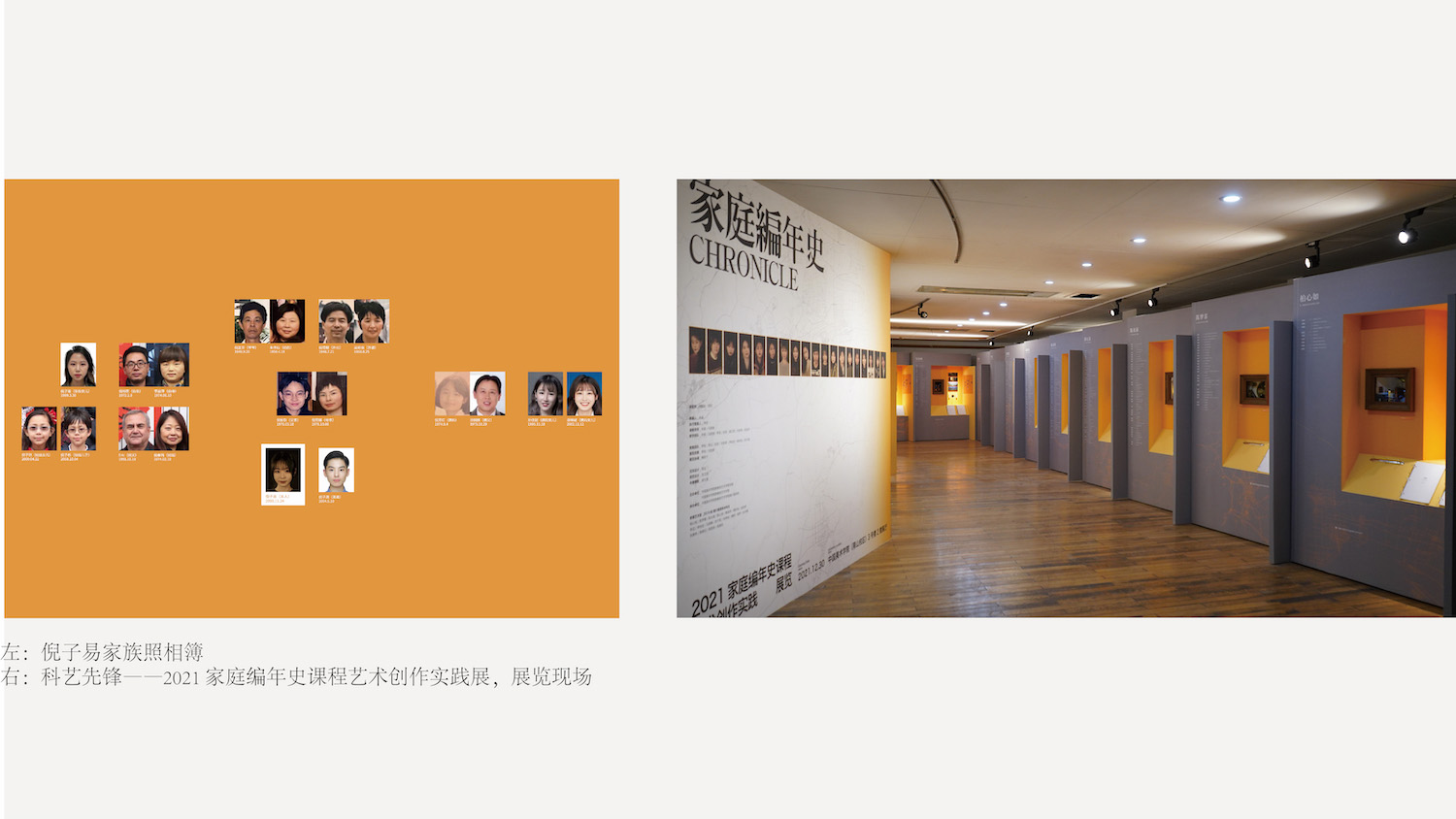事出有因:家庭编年史
MOTIVATION: Chronicle of A Generation
课段由场次安排、场景设定和场面调度三方面构成。2015年媒介展演系成立至今,从2013级到2021级,九届,上过这门课程的本科生共一百六十五人。2023 年,事出有因:家庭编年史课程展,以媒介展演系 2018 级 - 2021 级七十九位本科生的家庭编年史课程产出为主体展示内容,根据西岸艺术中心 B 馆空间条件,对课程展进行了重新梳理与整合。家庭编年史课程“以获得目光为目的”。七十九位同学以各自的家庭、家族和家乡为叙事对象,通过开掘家庭、家族和家乡这些辽阔的、取之不尽的叙事矿藏,获得看待、呈现事物和事情的能力。课程展以家庭场景微缩模型、家族大事记、家族编年史剧集大纲、家族照相簿、家乡情景渲染图及家乡城市地图等六种形式呈现。通过场景、情景和图景,展开家庭变迁,演化社会进程,透视国家图景。七十九位同学、七十九份家庭编年史。一代去,一代来。一代又一代。生老病死、苦与痛、爱和荣耀。每一个家庭、家族和家乡都是丰富的和独特的,如同伊塔罗·卡尔维诺对鲍里斯·帕斯捷尔纳克的《日瓦格医生》的评价:“不是大人物创造历史,也不是小人物。历史运作如植物王国,如春天树木的转变。”
A course segment consists of three components: session arrangement, scene setting, and staging. Since the establishment of the Media Performance Department in 2015, a total of 165 undergraduates from the 2013 to 2021 academic years have taken this course over nine semesters. In 2023, due to specific circumstances, the "Family Chronicle Course Exhibition" was held, featuring the outputs of 79 undergraduates from the 2018 to 2021 academic years in the Media Performance Department. Based on the spatial conditions of Hall B of the West Bund Art Center, the course exhibition was re-organized and integrated. The Family Chronicle Course aims to "capture attention." The 79 students took their respective families, clans, and hometowns as narrative subjects, tapping into these vast and inexhaustible narrative treasures of family, clan, and hometown to acquire the ability to view and present things and events. The course exhibition was presented in six forms: miniatures of family scenes, family timelines, outlines of family chronicle dramas, family photo albums, renderings of hometown scenes, and maps of hometown cities. Through scenes, situations, and vistas, the exhibition unfolds family changes, evolves social processes, and offers perspectives on the national landscape. Seventy-nine students, seventy-nine family chronicles. One generation passes, another comes. Generation after generation. Birth, aging, sickness, death, pain, love, and glory. Each family, clan, and hometown is rich and unique, akin to Italo Calvino's evaluation of Boris Pasternak's "Doctor Zhivago": "It is not the great men who make history, nor the small men. History operates like the kingdom of plants, like the transformation of trees in spring."
中国美术学院 跨媒体艺术学院 媒介展演系
School of Intermedia Art Media Scenography Department of China Academy of Art
中国美术学院跨媒体艺术学院媒介展演系是由牟森于 2015 年创办。媒介展演系基于叙事工程,建构媒介透视。对应空间和时间,通过展示和演出,呈现展开与演化。空间和时间面向的创作品类为巨构和剧集。以产学研和产业链为手段,以跨媒介、跨学科、跨领域为方式,聚焦具体产业面向,强调媒介融合和领域打通,擅长整体构造的叙事序列。跨媒体艺术学院:跨媒体艺术学院成⽴于 2010 年 9 ⽉,其宗旨在于:促进媒体技术开发,推动当代艺术实验,从媒体中发掘创意,从技术中发是⼈⽂ ; 以媒体实验、艺术创作、⽂化研究、策展实践四维互动的教育格局,在国际平台上推动当代艺术的跨学科研究和跨领域实践。学院直⾯当代媒介技术变⾰与⽂化语境变迁,应对世界视觉⽂化的发展势态和创意⽂化的发展需求,涵盖实验影像、虚拟现实、互动装置、多媒体展演、图像与视觉⽂化研究、复合造型与观念研究、空间多媒体与社会学研究等多个专业领域,曾被美国《亚太艺术杂志》评为“亚洲最值得期待的当代艺术教育机构”。
The Media Performance Department of the School of Intermedia Art at China Academy of Art was founded by Mou Sen in 2015. Based on narrative projects, the Media Performance Department constructs media perspectives. Corresponding to space and time, it presents unfolding and evolution through exhibitions and performances. The creative categories targeted by space and time are monumental works and dramas. Utilizing industry-academia-research collaboration and the industrial chain as means, and cross-media, cross-disciplinary, and cross-field approaches as methods, the department focuses on specific industries, emphasizes media integration and field connectivity, and excels in constructing narrative sequences as a whole. The School of Intermedia Art: Established in September 2010, the School of Intermedia Art aims to promote the development of media technology, drive contemporary art experiments, discover creativity from media, and develop humanities from technology. With a four-dimensional interactive educational landscape of media experiments, artistic creation, cultural research, and curatorial practice, it promotes interdisciplinary research and cross-field practice in contemporary art on an international platform. The school confronts the changes in contemporary media technology and cultural contexts, responds to the development trends of world visual culture and the development needs of creative culture, and covers multiple professional fields such as experimental imaging, virtual reality, interactive installations, multimedia performances, image and visual culture research, composite modeling and conceptual research, and spatial multimedia and sociological research. It has been rated by the US-based "Asia Pacific Arts" magazine as "Asia's Most Promising Contemporary Art Education Institution."
